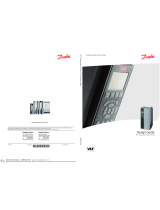
FC 300 Design Guide
Options and Accessories ......................................................................... 45
Brake Resistors ..................................................................................... 45
Remote-mounting Kits for LCP ................................................................. 45
External 24 V DC Supply ......................................................................... 45
IP 21/IP 4X/ TYPE 1 Enclosure Kit ............................................................ 45
IP 21/IP 4X/ TYPE 1 Enclosure Kit ............................................................ 46
LC Filters .............................................................................................. 46
Ordering Numbers ................................................................................. 47
Electrical Data ....................................................................................... 51
Efficiency .............................................................................................. 54
HowtoOrder .................................................................................... 55
Drive Configurator ................................................................................. 55
Ordering Form Type Code ....................................................................... 56
HowtoInstall .................................................................................. 59
Mechanical Installation ........................................................................... 59
Accessory Bag ...... ................................................................................. 59
Safety Requirements of Mechanical Installation .......................................... 60
Field Mounting ....................................................................................... 61
Electrical Installation .............................................................................. 61
Connection to Mains and Earthing ............................................................ 61
Motor Connection .................................................................................. 63
Motor Cables ......................................................................................... 64
Electrical Installation of Motor Cables ....................................................... 65
Fuses ................................................................................................... 65
Access to Control Terminals ..................................................................... 67
Electrical Installation, Control Terminals . ................................................... 67
Control Terminals .. ................................................................................. 68
Electrical Installation, Control Cables ........................................................ 69
Switches S201, S202, and S801 .............................................................. 70
Final Set-Up and Test ............................................................................. 71
Tightening Torque ........... ....................................................................... 72
Safe Stop Installation ............................................................................. 73
Safe Stop Commissioning Test ........... ...................................................... 73
Additional Connections ........................................................................... 74
24 V Back-Up Option .............................................................................. 74
Load Sharing ......................................................................................... 74
Installation of Loadsharing ...................................................................... 75
Brake Connection Option .... .................................................................... 75
Relay Connection .. ................................................................................. 75
Relay Output ......................................................................................... 76
Control of Mechanical Brake .................................................................... 76
Parallel Connection of Motors ................................................................... 77
Direction of Motor Rotation ........ ............................................................. 77
Motor Thermal Protection ........................................................................ 77
Installation of Brake Cable ...................................................................... 78
Bus Connection ..................................................................................... 78
High Voltage Test ................................................................................... 78
Safety Earthing ..................................................................................... 79
Electrical Installation - EMC Precautions .... ................................................ 79
Use of EMC-Correct Cables ...................................................................... 80
Earthing of Screened/Armoured Control Cables .......................................... 82
Mains Supply Interference/Harmonics ....................................................... 83
2
MG.33.B2.02 - VLT is a registered Danfoss trademark






















